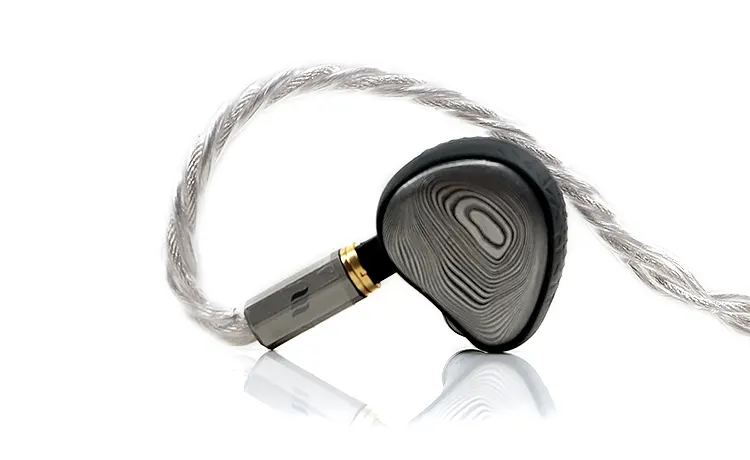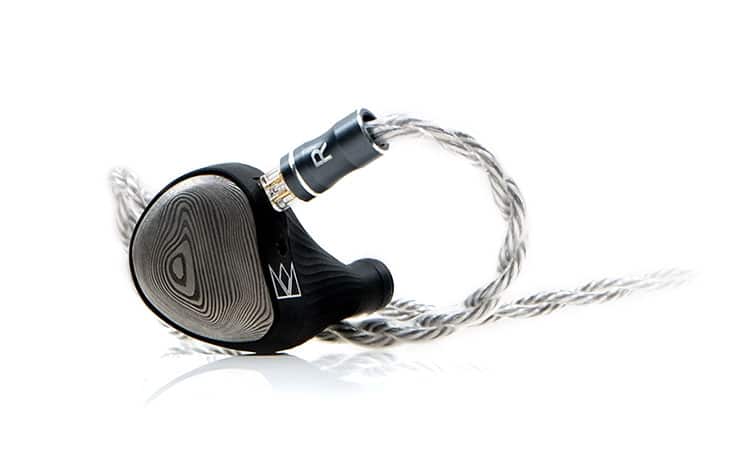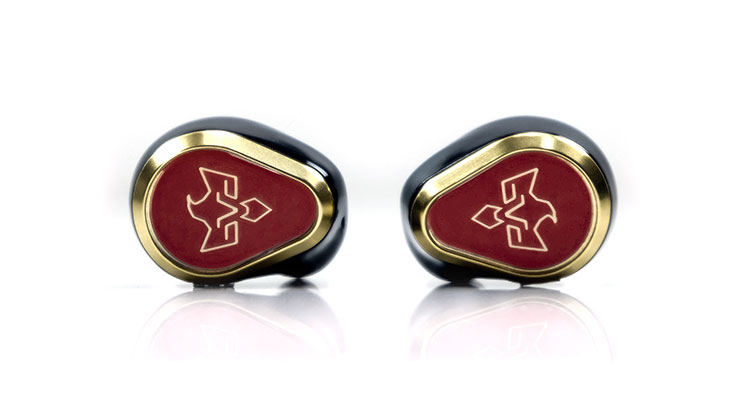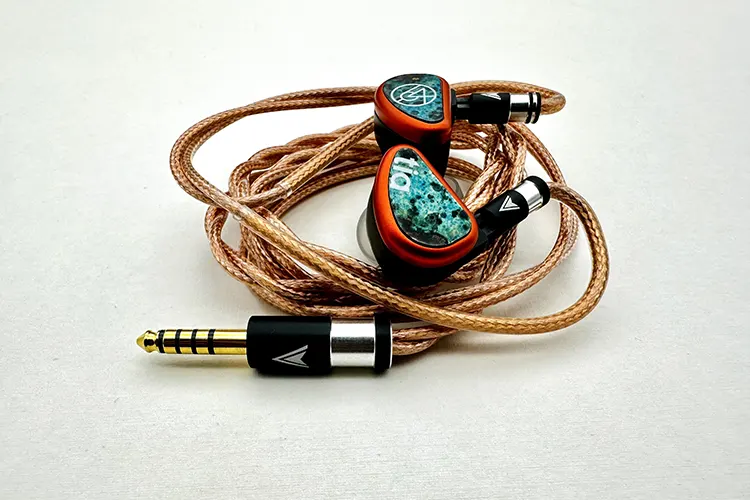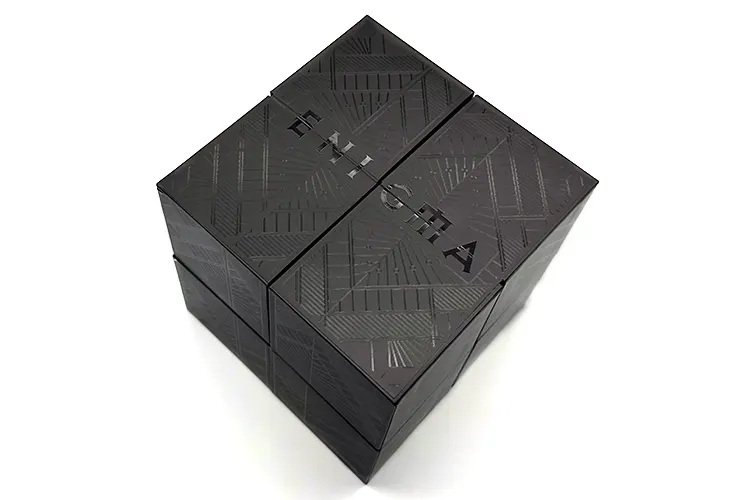Select Comparisons
Noble Audio Viking Ragnar
Released in late 2022, the Viking Ragnar is Noble Audio’s flagship wired universal in-ear monitor and won the Top Gear Best Universal IEM award for that year.
Technical
The Viking Ragnar features a total of 10 drivers, compared to the 12 drivers in the Enigma. Both IEMs employ a dual dynamic driver setup for the lows, but the Enigma adds two additional balanced armature drivers to enhance bass production.
Both models use four balanced armatures for the midrange and four electrostatic drivers for the high frequencies.
With an impedance of 17Ω and a sensitivity of 112dB, the Viking Ragnar can require more power to reach its full potential. Both IEMs take similar volume levels on my LPGT; however, the Ragnar needs more effort in the chain to sound full and truly shine.
Design
The Ragnar and Enigma showcase very different design philosophies. The Ragnar features a distinctive faceplate crafted from Damascus stainless steel with a unique wavy or watery pattern that emerges from the forging process. This random, intricate pattern adds a touch of artistry.
While both IEMs boast minimalistic yet premium designs, I’m particularly drawn to the Enigma’s design, which incorporates a sapphire crystal in the center of a futuristic faceplate—a novel and striking design language.
In terms of fit, the Ragnar has smaller shells and narrower nozzles compared to the Enigma. The Ragnar’s design makes it slightly more comfortable and less protruding, though both IEMs have similar weights and deep, secure insertions thanks to their longer nozzles.
Regarding cables, both IEMs come with aftermarket options, but Ragnar’s bespoke Magnus cable, crafted by Wagnus of Japan, stands out. It’s thicker, heavier, and built to a higher standard compared to the Effect Audio cable included with the Enigma.
Despite this, I prefer Enigma’s cable for its ease of handling. Both IEMs come with a 4.4mm balanced connector, but the Magnus cable features a Pentaconn connector.
Performance
The performance of the two IEMs varies significantly. The Ragnar delivers a more energetic and lively sound profile, while the Enigma offers a balanced and controlled approach.
The Ragnar lacks the smoother sound of the Enigma in the midrange and higher frequencies. Unlike the Enigma’s rich, thick lows, Ragnar’s dual dynamic drivers produce a faster bass with quicker attack and decay, which is leaner in comparison.
The Enigma has a thicker and meatier bass, boosted by the sub-bass rumble and mid-bass punch, whereas the Ragnar’s bass is more neutral and restrained by comparison. Ragnar maintains the goodness of a dynamic driver’s bass, but the impact is softer.
In the midrange, the Enigma has an edge, sounding warmer and more natural with denser, thicker vocals. The mids are lusher and less energetic than those of the Ragnar.
While Ragnar maintains exceptional transparency and clarity, the Enigma’s midrange can seem a bit veiled in comparison. Both IEMs perform similarly in the lower midrange, but the Ragnar edges out with more energy in the upper midrange. This can occasionally add to some sibilance in female vocals.
The Ragnar offers a pronounced treble presence between 5-10kHz, giving it a brighter and cleaner tonal quality. This increased treble detail, however, can be fatiguing and harsh, often requiring tip and cable rolling to mitigate the harshness. Compared to the Ragnar, the Enigma’s treble is more subdued, with less air and sparkle.
Technically, the Ragnar’s soundstage is narrower but deeper and taller than the Enigma’s, making the stage feel more spread out and providing better imaging. The Ragnar allows instruments to have more space, and with a powerful source, it can deliver an even more spacious stage.
All Ragnar needs is a touch of warmth and some additional power to shine. Thankfully, it pairs well with the Lotoo Paw Gold Touch, which adds some weight to the bass and warmth to the midrange. For me, the SpinFit W1 ear tips bring out the best bass response on Ragnar.
Vision Ears Phönix
Technical
The Vision Ears Phönix is the brand’s current flagship universal IEM, priced similarly to the Enigma. It features an all-BA design with a total of 13 drivers; 4 dedicated to the lows, 4 to the mids, and 4 to the highs, and a super tweeter for ultra-highs.
Given the different driver setups between the Phönix and Enigma, their textures and tonal qualities are distinct.
The Phönix is rated at 13Ω @ 1KHz with 125dB SPL, compared to the Enigma’s 10Ω @ 1KHz and 121.5dB SPL. This means the Phönix requires significantly less power.
On my LPGT, I found myself needing a volume level of nearly 30 for the Phönix, whereas the Enigma required a level above 40.
Design
Considering that the Phönix was released over two years ago, its design is more simplistic by today’s standards. The aesthetics and design language differ greatly from the Enigma, ultimately coming down to personal preference.
The Phönix sports a sleek, jewellery-like design with a vibrant red faceplate that might appeal to some. Its shells are made from lighter material compared to the more robust aluminum shells of the Enigma.
In terms of fit, the Phönix is more comfortable to wear. Its slimmer IEM shells don’t protrude and sit closer to the ear. Phönix has a nozzle width and length almost identical to the Enigma.
The cable on the Phönix is thinner and lighter than the Effect Audio cable on the Enigma, which offers better aesthetics and build quality. The Phönix cable I tried had a 2.5mm termination.
Performance
The Enigma’s dual dynamic driver setup gives it a more robust and impactful bass when compared to the Phönix.
While both IEMs offer decent sub-bass performance, the Enigma pulls ahead in the mid-bass, whereas the Phönix’s softer mid-bass lacks the punchiness needed for a truly engaging low-end. However, considering the Phönix is an all-BA IEM, it still delivers respectable bass quality.
In the midrange, the Enigma outshines with greater transparency and clarity. Vocals on the Enigma are more prominent, dense, and closer to the ear, whereas the Phönix’s vocals appear slightly thinner due to a lack of weight and body in the lower mids.
Both IEMs share a warmth in their sound, though the Phönix exhibits a bit more warmth overall.
When it comes to treble, both IEMs have a controlled and somewhat tamed presentation with no excessive detail or energy. However, the Enigma offers a crisper, slightly airier treble with more defined details.
Overall, the Enigma is more resolving, with micro-details being more pronounced. The soundstage on the Phönix feels a bit more constrained, with less width and depth when compared to the Enigma, where instruments have more space to breathe, resulting in a more spread-out and open sound.
The Enigma handles busier tracks better, maintaining clarity and separation in complex passages.
64 Audio Fourte
Technical
The 64 Audio Fourté is a flagship IEM that features just four drivers, compared to the twelve drivers on the Enigma. These include a tia high driver, a high-mid driver, a tia mid driver, and a dynamic driver for the lower frequencies.
The Fourté challenges the common belief that more drivers automatically lead to better sound quality, proving that fewer drivers can still deliver exceptional performance.
The Fourté is rated at 10Ω @ 1KHz with 114 dB SPL, making it slightly easier to drive compared to the Enigma, which has the same impedance but a higher sensitivity at 121.5 dB SPL.
In practical terms, I found that on my LPGT, the Fourté required a volume level of nearly 35, while the Enigma needed a level above 40.
Design
Design-wise, the Fourté is quite simplistic and looks better in person than in photographs, where its vibrant-colored faceplate might seem more striking.
Like the Enigma, the Fourté’s shell is machined from solid aluminum, with a black anodized finish and a copper-colored faceplate. Each faceplate has a unique patina pattern.
Both the IEMs have quite robust builds. However, I find the Enigma’s design more appealing, with its futuristic look that I believe will remain relevant in the future.
The Fourté’s shells are lightweight and slimmer, making them more comfortable on the ears. Its narrow and long nozzle allows for a deep insertion, enhancing the fit.
As for the cable, the Fourté comes with a 3.5mm-ended silver-plated OCC copper cable, which is functional but minimal in design. In contrast, the Enigma’s Effect Audio cable feels sturdier and offers better aesthetics, making it a more inspiring choice overall.
Performance
The Enigma offers a bass with more quantity due to the mid-bass region, providing a textured sub-bass and a rounded mid-bass punch. Its bass has a slower decay, lingering a bit longer, which adds to its rich texture.
The Fourté excels in sub-bass with deep extension, but its bass has a faster decay, resulting in a tighter, more immediate impact that lacks the lingering effect of the Enigma. While both IEMs deliver excellent bass definition, I prefer the Enigma’s more textured and punchy bass.
In the midrange, the Fourté stands out with impressive transparency and clarity, offering just a hint of warmth. The Enigma has more warmth in its midrange, delivering a fuller, more musical sound with thicker, denser vocals.
The Enigma’s mids have more note weight and a sweet lingering effect, with smoother and well-extended upper mids, making the vocals and midrange feel more realistic and engaging. The Fourté maintains a clean presentation with more energy, giving the mids a slightly brighter character.
In the treble region, the Fourté shines with plenty of sparkle and energy, appealing to those who enjoy a lively treble. However, it might be a bit too much for sensitive listeners.
For me, it strikes the right balance. While not as exciting in the treble region, the Enigma offers a smoother treble presentation with just enough detail and extension in the upper frequencies to remain satisfying.
The Fourté boasts a more holographic presentation, thanks to its incredible depth. While the width is almost comparable to the Enigma’s, the Fourté’s stage stretches taller and deeper, creating a more spacious sound.
The Fourté also edges out the Enigma in resolution, delivering crisp, precise details that vividly paint the sonic picture. Both IEMs offer excellent instrument separation and easily handle complex tracks, however, the Fourté has a slight advantage in channel-to-channel imaging.
My Verdict
The Softears Enigma stands out as one of the most unique-looking and well-balanced high-end in-ear monitors I’ve encountered. The craftsmanship and attention to detail that Softears put into the Enigma are evident in its distinctive design and thoughtful packaging.
With a very approachable tuning, this IEM is versatile, making it enjoyable across a wide range of genres.
Its true-to-life timbre, smooth mids, and beautifully rich vocals create a captivating listening experience, further enhanced by a punchy yet balanced low-end. Revisiting older songs in my library with the Enigma was a fun and revealing experience.
In addition to its musicality, the Enigma’s solid technical capabilities make it an ideal choice for those who prioritize an engaging, musical sound.
While it has plenty of bass, the balanced tuning won’t necessarily attract bassheads. There is a slight lack of airiness that can lead to an overly smooth presentation. However, this can be easily addressed by experimenting with different sources for better synergy.
If you favor a sound that leans toward musicality with a relaxed tuning, the Enigma is sure to please. As a flagship in-ear monitor, it’s a fine achievement that Softears can be justifiably proud of.
Softears Enigma Specifications
- Driver Configurations: 2 Dynamic Drivers + 6 Balanced Armatures + 4 Electrostatic Drivers
- Frequency Response: 8Hz-42kHz
- Impedance: 10Ω
- Sensitivity: 121.5 dB/Vrms @ 1kHz
- Crossover 4-way
- Weight: 9.1 g per side


